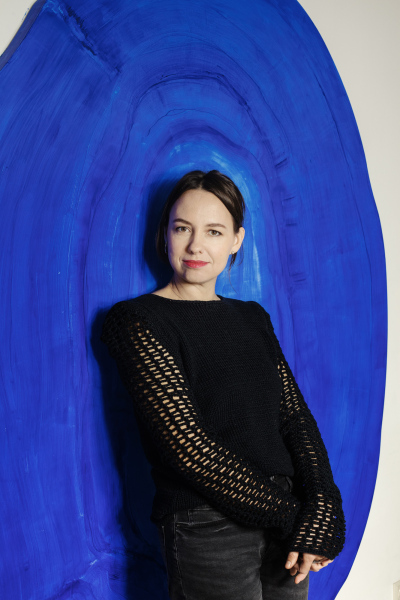-

Paula Zarina - Zemane
Born in Riga, Latvia, in 1988
Education:
2011- 2013 Art Academy of Latvia, Master of Arts degree in the Humanities, Painting department
2009 - Ecole superieure d'art de Lorient, France
2007 - 2011 Art Academy of Latvia, Bachelor of Arts degree in the Humanities, Painting department
1995 - 2007 Riga French Lyceum
Solo Shows:
2025 Stories in My Eyes, Draakon gallery, Tallinn, Estonia
2024/2025 Eyes Open, Closed, ASNI gallery, Riga, Latvia
2023 Possibilities, Tartu Art house, Tartu, Estonia
2021/2022 Changes, gallery MākslaXO, Riga, Latvia
2019 Bezgalības apziņas, Valmiera's Museum, Latvia
2018 One as Another, gallery Careva Contemporary, Riga, Latvia
2018 Nature's Soul, gallery Insignia, Cēsis Concert Hall, Cesis, Latvia
2017 The Still Point of the Turning World, ARSENĀLS Exhibition Hall of the Latvian National Museum of Art / Creative Studio, Riga, Latvia
2015 Awarenesses, gallery Māksla XO, Riga, Latvia
2015 The Great Coexistence, Fund's Art Needs Space (Mākslai Vajag Telpu) summerhouse gallery, Riga, Latvia
2015 Episodes, Liepaja's Museum, Liepaja, Latvia
2015 Awarenesses, Daugavpils Mark Rothko Art Center, Daugavpils, Latvia
2013 Hormone of Happiness, gallery Maksla XO, Riga, Latvia
Selected Group Exhibitions:
2024 The Small Art Fair, represented by ASNI gallery, Riga, Latvia
2024 Art in a forest, in a meadow and by the horizon, curated by Daiga Rudzāte, Una Meistare, energART -Arterritory's nomadic gallery in 'Dūrmuiža", Latvia
2023 Standpoint, curated by Daiga Rudzāte, Una Meistare, energART - Arterritory's nomadic gallery, Riga, Latvia
2023 Why Painting Works, curated by Juriaan Benschop, Kourd gallery, Athens, Greece
2022 Three of a Kind, curated by Jurriaan Benschop, Kogo gallery, Tartu, Estonia
2019 Vienna Contemporary 2019, represented by Careva gallery, Vienna, Austria
2018 Vienna Contemporary 2018, represented by Careva contemporary gallery, Vienna, Austria
2016 Contemporary Landscape, curated by Daiga Rudzāte, Old Brewery, Cēsis, Latvia
2015 Tension. The Young in Latvian Painting III, Latvian National Museum of Art, the Arsenals Exhibition Hall, Riga, Latvia (catalog)
2015 Positions Berlin 2015, represented by gallery Māksla XO, Berlin
2015 Imago Mundi – Luciano Benetton Collection, Fondazione Cini, Isola di San Giorgio Maggiore, Venice, Italy
2015 Captive Beauty in Miniature, gallery Māksla XO, Riga, Latvia
2013 Myths and Legends of Eastern Europe part 2, gallery LWW, The Netherlands, Amsterdam
2013 Pink, gallery Maksla XO, Riga, Latvia
2012 JAUNUMS! Fresh Latvian Painting, Tartu Art house, Estonia
2012 fashion and painting exhibition CABARET, Notting Hill Brasserie, London
2012 MIGRATION - exhibition of students and professors of the Art Academy of Latvia, Permanent Representation of Latvia to the EU, Brussels
2012 International art festival A. Kuindgi memorial, Contemporary Art Center of A. Kuindgi, Art Museum of A. Kuindgi, Gallery Art-Luks, Mariupole, Ukraine
2012 CHA - 2012. Roads & Tracks. Moscow International Art Salon, Moscow, Russia (catalog)
2011 Young People Icons, Gallery Art Promotion02, Germany
2011 Where am I?, The Festival of Winter in Sigulda, Latvia
2010 Urbanchildren. The Young in Latvian Painting II, Latvian National Museum of Art, the Arsenals Exhibition Hall, Riga, Latvia (catalog)
Other Projects:
2022 Drawings for Andrejs Verhoustinskis documentary film "Nr. 105555" (National film award "Lielais Kristaps" nomination for the best short documentary)
2021 Illustrations for Janis Rubiks and Beate's Zviedre's music album "Kad es nomizojos"
2019 Participation in the Art Academy of Latvia project "LMA 100"
2017 Participation in Ilze Lasmane Brože project "SkaņuSaite in Latvia"
2015 Illustrations for a poem book "Rainis. Cilvēks"
2015 Participation in Luciano Benetton's project Imago Mundi - Contemporary Artists from Latvia
2015 Illustrations for a poem BOOK
 of Benno Poplianski
of Benno Poplianski2014 Participation in drawing and music performance “PoetryButterfly School”, directed
 by Varis Klausitajs
by Varis Klausitajs2013 Visual design (11 paintings) for the music album of the band "The Sound Poets"
Nominations and Awards:
2023 Nomination for National film award "Lielais Kristaps" in the category "best short documentary". Andrejs Verhoustinskis documentary film "Nr. 105555".2015 Nomination for the annual award "Kilograms kultūras" in the category "Happening of the Year". Four Exhibitions (curated by Inga Šteimane), Daugavpils Mark Rothko Art Center, Daugavpils, Latvia
Residencies:
2014 Cité International des Arts, Paris, France
Scholarships:
2011 Ludolfs Liberts's Fund
 Stipendium for excellent success in arts education and creative work.
Stipendium for excellent success in arts education and creative work.Works in collections:
VV Foundation
Silja Art collection
Epp and Martin Kruus collection
-